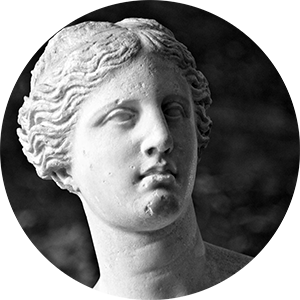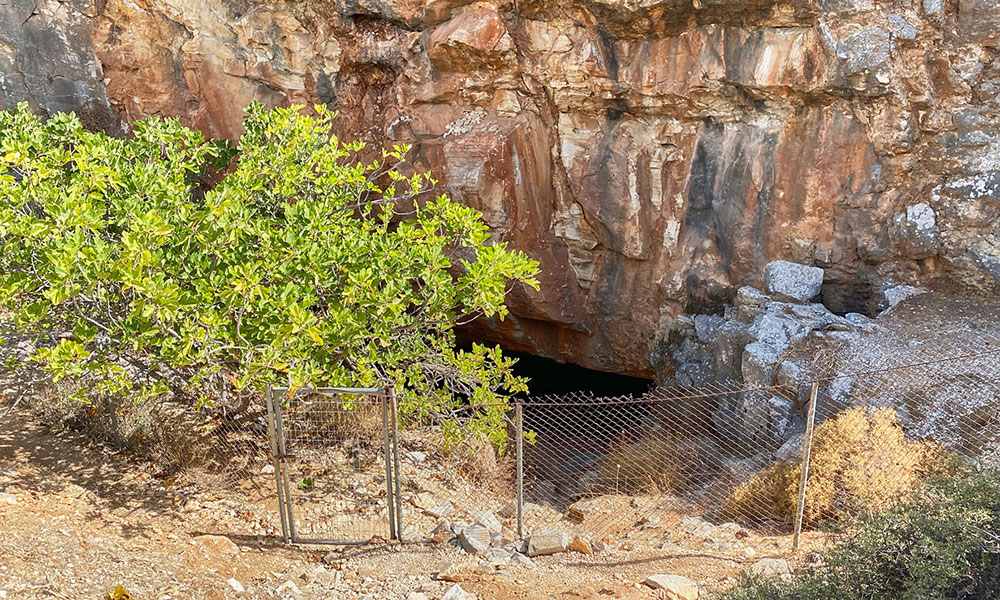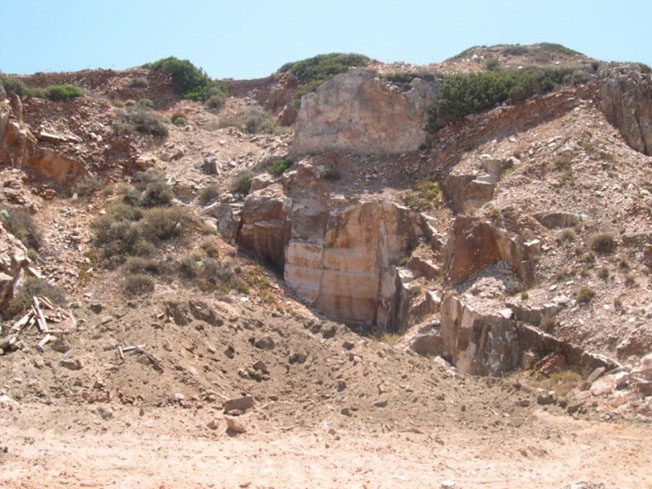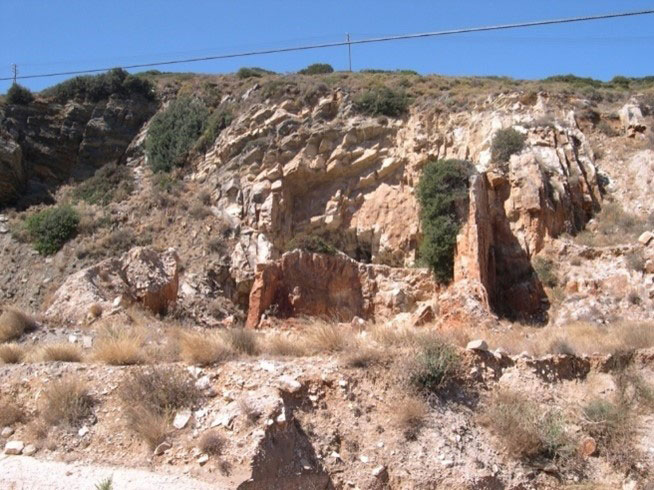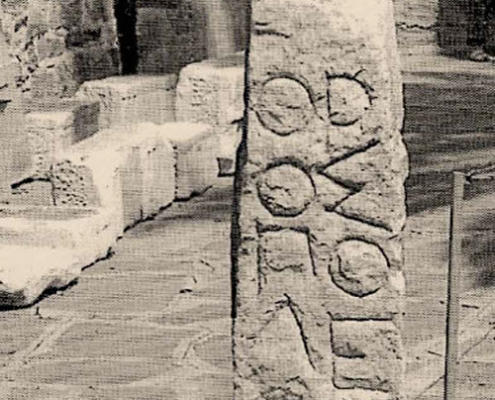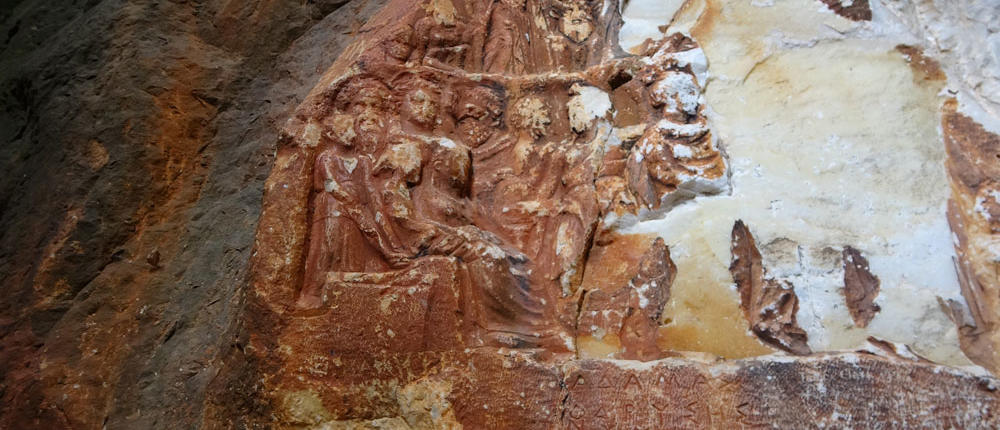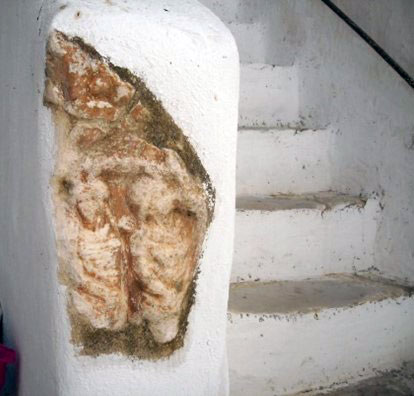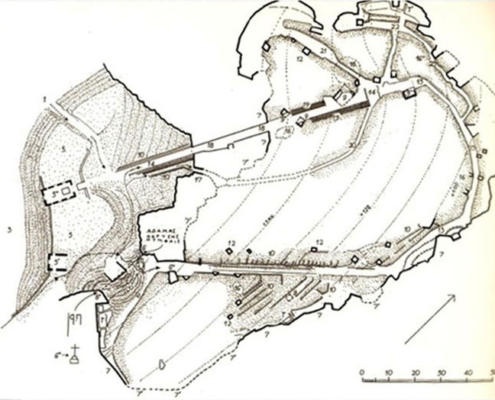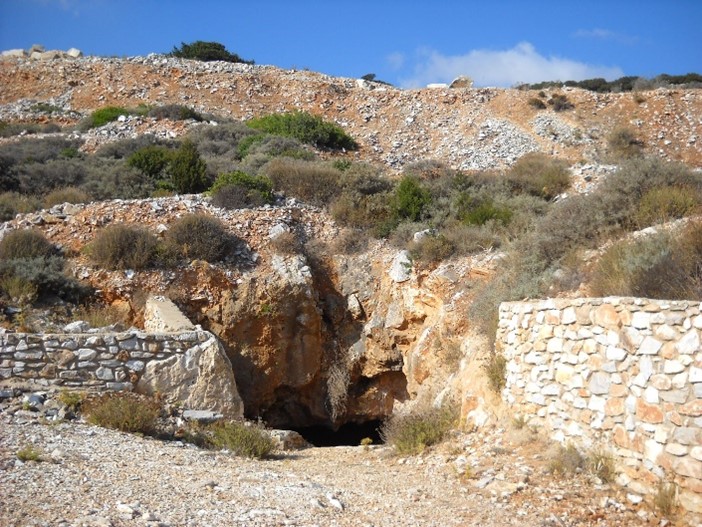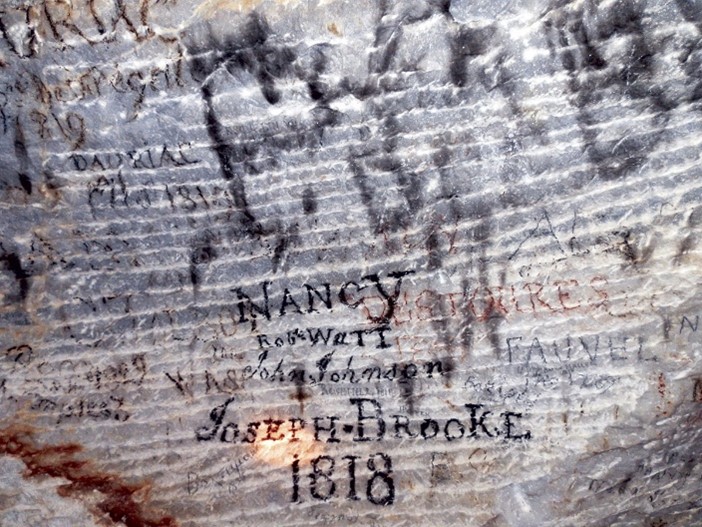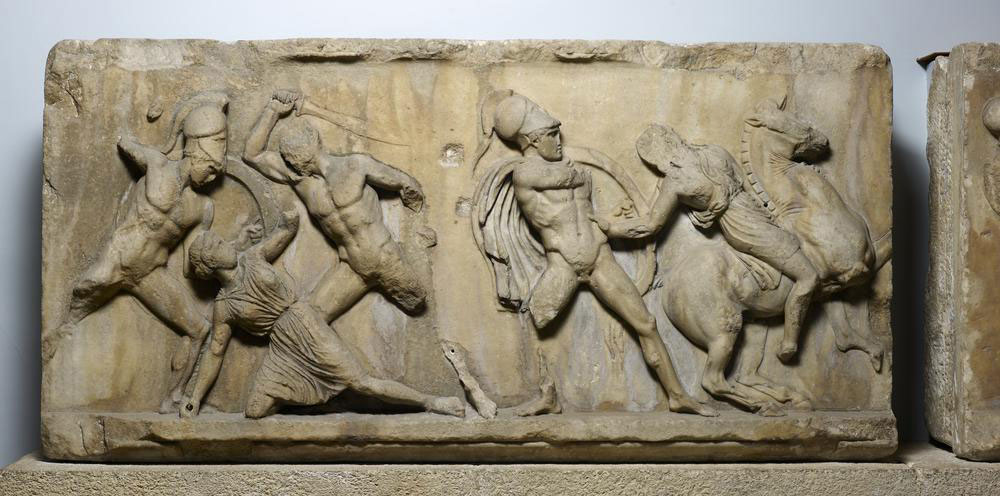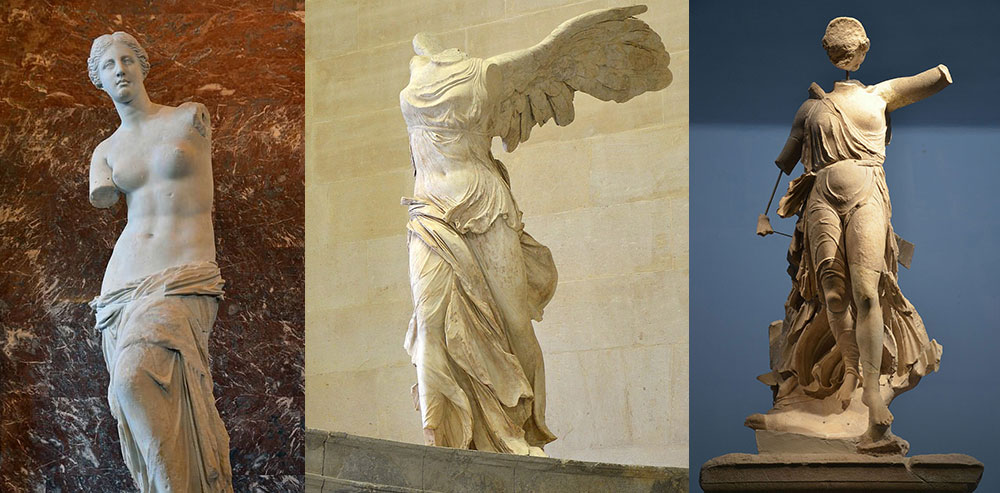Image 2: The quarry of the Nymphs
Image 3: The surface quarries at Lakkos (left) and the quarries at Spilies (right).
The Parian marble (Paria Lithos) was already used from the early Bronze Age, probably collected in the form of pebbles or lathis, to create figurines and utensils. In historical times, quarrying began in the 7th century BC, as evidenced by the tombstone with a seated female figure in low relief from the cemetery of Parikia, and gets intensified from the 6th century BC onwards, when Parian marble was systematically quarried in the form of boulders for sculpture and architectural purposes. The semi-worked objects found in the deposits of marble from the ancient exploitation in the pits and caves, including a stele with the inscription “city border” (Image 4), testify to the existence of marble workshops at the site of the quarries and indicate that the state probably controlled at least part of the exploitation.
From the quarries in the valley of Skarpathiotis (or Xeropotamos, on later maps) in Marathi comes the most famous variety of Parian marble, the high-quality lychnite stone, sought after for statuary because of its quality, whiteness and high transparency and light transmission (3.5 cm compared to 2.5 cm of the Carrara marble and 1.5 cm of the Pendellikon marble) which, in excellent quality material, can reach up to 12 cm!
In the Marathi quarries, the excellent marble layer, 1-3 m thick, is found among other thicker cyan-coloured layers and is visible in various places in the valley. The uncovering of the excellent layer is apparently due to the digging action of the torrent from where the surface exploitation would have initially started, which gradually evolved into deep mining to monitor the layer, and subsequently into the underground. The marble layers are not horizontal but strongly folded with an upward curvature. This folding also determined the method of exploitation, i.e. either by the application of right grades when the gradient is high or by the ‘chamber and pillar’ method when the gradient is lower. The Marathi quarries are developed extensively over hundreds of metres, with the occasional maintenance of masses of stones (pillars) that act as pillars and the presence of stone walls, i.e. accumulations of stones and mud from the first roughing, which are sometimes held together by lateral walls that create corridors between them.
The best known of the Marathi quarries is that of the Nymphs, which takes its name from the votive inscribed relief carved into the natural stone on the left side of the south gallery, a tribute by Adamantas from Thrace to the Nymphs, a work of the 4th century BC (Image 5). The underground area of the quarry is 190m long in an N-S direction, and 50-120m wide, with a height of up to 3-4m and an overlying mass ranging from 20-100m (Image 6). In the southern part of the quarry, which is the oldest, the unstratified masses (pessoi) are 6-10m apart, while their thickness varies according to the thickness of the overlying mass. Of the approximately 100 in total pessoi estimated to have been in the quarry, 20 are visible today, while as many more are visible through the small gaps in the stone fillings.
Image 4: City border, 4th century BC. Found in the quarry of Lakkoi.
Image 5: The inscribed relief of the Nymphs and part of it, detached at the end of the 19th century, now inlaid in the monastery of St. Minas.
Image 6: Floor plan of the quarry of the Nymphs (Manolis Korres).
The current image of the quarry of the Nymphs is largely due to the work of the Belgian Company and the Greek Marble Company of Paros, which attempted to re-exploit the quarry in the 19th century. At that time, the two main corridors in the northern and southern part of the quarry and other smaller ones were formed by removing thousands of cubic meters of ancient mud, removing some of the ancient support passages and creating new strong retaining walls. The re-exploitation was fortunately aborted, but thanks to these works the underground quarry can now be visited over a large area and is seen in a way that was not possible even during its ancient phase of operation. To lift the material and exploit the quarry, a complex mechanical system was constructed, with various buildings (Image 1) and a railway line leading to the company’s factory in Parikia, opposite the old pier where a 20-tonne crane was operated. The surviving remains of these facilities are important monuments of 19th-century industrial architecture.
600 m further south-west is the second large quarry in the Marathi area, the quarry of Pan, which has no particular differences in shape and dimensions compared with the quarry of the Nymphs, which is also sloping but with fewer stones due to the way in which the quarry was developed. The production should also have been similar to that of the quarry of the Nymphs and is estimated at 100 000 cubic meters of usable volume. The accessible position of its entrance (Image 7), before it was narrowed by debris and collapses, and the partial stone filling inside it, made this quarry almost always accessible to visitors, unlike the quarry of the Nymphs, where what attracted visitors was mainly the relief at the entrance, as the filling of the quarry with lathis prevented an in-depth visit. On the walls of the quarry of the Pan, many inscriptions can be seen with the names of visitors who descended into the deeper areas, such as Choiseul Guffier 1176, Fauvel 1789, J. Power 1813, Joseph Brooke 1818, Cordier 1958, etc. (Image 8)
Image 7: The entrance to the quarry of Pan
Image 8: Names of visitors to the quarry of Pan
The excellent quality marble extracted from the quarries of Mount Marpissa contributed decisively to the economic and cultural development of ancient Paros, which was one of the most important artistic centres of the ancient world and produced some of the greatest sculptors of antiquity, such as Aristion, Agoracritus, Aristander, Scopas, Thrasymedes and others. Masterpieces of sculpture (Aristodikos, Pais of Kritios, Nike of Paionion, Hermes of Olympia, Aphrodite of Milos) and architecture (Treasure of Siphniots, pediments of the Temple of Pisistratus on the Acropolis, pediments of the Temple of Zeus in Olympia, the frieze of Mausoleum of Halicarnassus, etc.) were created from Parian stone (Image 9-10) and decisively shaped the art of ancient Greece and contributed to its dissemination to the West.
It is evident that the underground quarries of Marathi, in conjunction with the quarries at Lakkoi, Spilies and Thapsana, constitute a most crucial chapter in the history not only of Paros but also of the ancient Greek and Roman world in general, a leading and complex work of geology, technology, history and art, of national and global importance, which is absolutely necessary to be preserved and highlighted.
Image 9: Part of the frieze of the Mausoleum of Alikarnassos
Image 10: Aphrodite of Milos, Nike of Samothrace and Nike of Paionios
Zozi Papadopoulou
Head of the Department of Prehistoric and Classical Antiquities and Museums of the Department of Prehistoric and Classical Antiquities of Cyclades
Selected bibliography
G. Gruben, ‘Marmor und Architektur’, in Paria Lithos (eds. D. Skillardi, D. Katsonopoulou) Athens 2000 (reprint 2010), 125-138.
N. Herz, “The Classical Marble Quarries of Paros. Paros-1, Paros-2 and Paros-3”, in Paria Lithos (op. cit.), 27-33.
G. Kokkorou-Alevras, “The use of distribution of Marian Marble during the Archaic Period” in Paria Lithos (op. cit.), 143-153.
M. Korres, ‘Underground Quarries of Paros’, in Paria Lithos (eds. D. Skillardi, D. Katsonopoulou) Athens 2000 (reprint 2010), 61-82.
M. Korres, From Penteli to the Parthenon. The ancient quarries and the history of an unfinished Doric colonnade of the first marble Parthenon , Athens 1994 (2nd edition), especially 120-121.
An. K. Orlandos, The structural materials of the ancient Greeks, Athens 1958.
D. Skillardi “Observations on the quarries of Spilies, Lakkoi and Thapsana on Paros” in Paria Lithos (op. cit.), 35-59.
